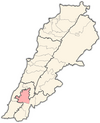|
Zawtar al-Sharqiyah
Zawtar al-Sharqiyah (Arabic: زوطر الشرقية) is a municipality overlooking the Litani River in the province of Nabatieh in South Lebanon (85 km from Beirut; 9 km from Nabatieh; 475 m (1558ft) above sea level). Its population exceeds 4,000, most of whom depend on tobacco farming as their main or supplementary source of income. The town has one intermediate public school, one nursery, and one partially functioning health center affiliated with the Ministry of Social Affairs.[1] EtymologyIn Aramaic, Zawtar means the small or the event. In the Syriac language, it is what used to be offered to worshipped idols from flour, butter, and honey, back in antiquity. Popular folk tales attribute the word to the abundance of grapes, as during its past times, the town was known as a wine village, where the alcoholic beverage was known as Zawtari wine. Camel caravans used to come from the Arabian Peninsula in the pre-Islamic times and load up on local grapes and wines. In another likely origin of the name, it is relative to the Phoenician princess called Zouzasit, who lived in the town during the Phoenician period. Historic structuresThe ruins in Zawtar al-Sharqiyah are a continuation and extension of those in the neighboring town, Zawtar al-Gharbiyah. On the southern slopes, there are some natural caves. A mosque stands in the town and dates back to 1850 CE.  Modern eraIn 1995, Israel assassinated a local man, Rida Yassin, better known as Abu-Ali Rida, in the village.[2] DemographicsIn 2014 Muslims made up 99.29% of registered voters in Zawtar al-Sharqiyah. 98.73% of the voters were Shiite Muslims.[3] References
External links
|
||||||||||||||||||||||

